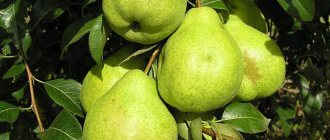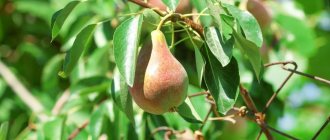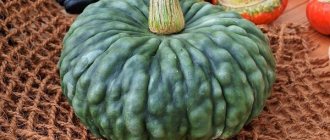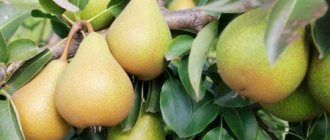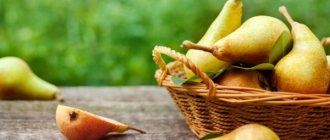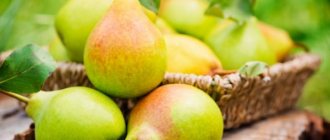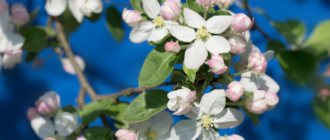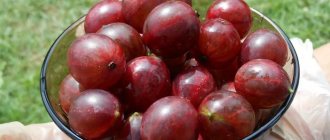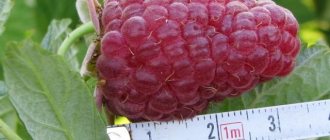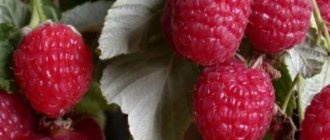Pear Marble.
Description of the variety
The Marble pear variety turned out to be autumn, one of the earliest in this group. The tree is compact and productive, but does not bear fruit quickly.
The variety got its name for its unusual color. On the green surface of the fruit, the red blush is arranged in veins and spots, so that the pattern looks like a natural marble stone.
Characteristics of wood
The Marbled pear tree is medium-sized. The crown is wide-pyramidal in shape, with vertical branches. The tree is not very dense, the growth rate of the vegetative system is not very high. Over the years, the branches become drooping.
Description of fruits
Pear variety Marble.
The fruits look very attractive. They are above average in size, some are even large, weighing up to 220 grams. Their shade is green, then the blurred blush and rustiness creates such a marble effect.
The pulp is coarse-grained and has a very rich sweet taste, but at the same time soft and juicy. According to the tasting scale, the fruit received a well-deserved rating of 4.8 points.
Planting pear trees of the Marble variety
Marble pear is considered an unpretentious variety - it grows and bears fruit well in any soil and does not require special care (except for watering). To increase the yield and taste of harvested pears, it is necessary to choose the right area for planting - it should be well lit by the sun during the day, and the soil should be loose and sufficiently fertile.
Photo of a pear seedling
If the soil in the garden plot is sufficiently depleted, then it is recommended to add humus or compost (up to 10 kg per 1 m2) before digging in the autumn.
It is better to purchase planting material in nurseries or specialized stores.
EXCELLENT VARIETIES OF PEARS!
Summer Duchess pear (Williams) Veles pear August dew pear
When choosing Marble pear seedlings, you need to pay attention to the following:
- Trees should be no more than 2 years old. Older seedlings do not take root well in a new place, get sick, and as a result grow more slowly.
- The root system should consist of 4-5 strong and healthy roots, the length of which should be at least 30 cm. It is best to purchase seedlings with a closed root system - they can be planted throughout the summer period.
Photo of pear planting
Important!
Two-year-old Marble pear seedlings should have at least 3-4 side shoots that are strong, healthy and undamaged. The bark of the tree should be smooth and even, without cracks or other visible damage.
Marble pear can be planted both in spring and autumn.
In the spring, planting time must be calculated so that the return spring frosts pass - any cold snap is detrimental to this tree.
In the fall, the Marble pear is planted approximately 25-30 days before the onset of cold weather, so that this fruit tree has time to take root before the onset of winter.
How to plant pears - video
Moisture should not stagnate in the soil, so it is better to make sure that excess moisture leaves the tree trunk and dig a trench.
12-14 days before planting a pear tree, dig a hole with a diameter of 0.6 m and a depth of up to 0.8 m. The upper, more nutritious layer of the dug soil is mixed with organic matter and mineral fertilizers - humus, wood ash, superphosphate and potassium salt. If the soil is highly acidified, lime or dolomite flour should be added to it during autumn digging. A nutrient substrate is poured into the hole to fill 2/3 of its volume, and a peg is driven in near the center.
Photo of preparing the planting pit for the Marble pear
Diseased or dry roots of the seedling are pruned, and almost all the foliage is torn off the branches.
The seedling is placed in the center of the hole, the roots are straightened and the tree is tied to a driven support. Then the hole is filled with the remaining nutrient substrate, compacted and watered. For each planted tree, 3 buckets of water are added. The tree trunk circle is mulched on top with straw or dry leaves.
In spring, planted trees should be watered at least once every 6-8 days throughout the month so that the seedlings are well established.
The distance between this pear and other fruit trees should be at least 4-4.5 m.
Reviews
The most delicious pear I have ever tasted. It is very sweet and juicy, the juice flows down your fingers. Pears last 2 months maximum, this is a minus, although not a short period by the standards of an autumn variety.
Maria
Yalta
A very capricious pear, you need to constantly monitor it. She is afraid of water, but she needs to be watered constantly. At the same time, I made a drain so that the moisture did not stagnate. But pears are delicious.
Alexey Mikhailovich
Sochi city
I really love this tree, even despite its capricious nature. Well, at least it never gets sick. But the fruits are simply amazing, sweet and juicy.
Antonina Fedorovna
Mayskoe
Ripening, harvesting, storage and use of crops
The fruits begin to ripen in late August - early September. They can be consumed until the second ten days of October maximum. The shelf life is short - usually no more than 2 months, but these pears tolerate transportation well due to their dense peel.
You need to harvest the crop carefully, do not pull it, but break it off from the branch so that the fruit stalks are preserved.
The collected fruits should be immediately removed into the shade.
One of the most delicious pear processing products is marshmallows.
Store carefully selected pears without mechanical damage or wormholes, placing them in wooden or wicker containers. The layers are laid out with paper or hay (you can wrap each pear in newspaper). The storage temperature should be 1–3 °C.
Since Mramornaya is considered a dessert variety, it is usually consumed in its natural form and in fruit salads. But it can also be used for making juices, compotes, jams, marshmallows and other delicious homemade preparations.
Landing
The Marble variety pear is quite capricious when it comes to planting.
- Choose a location away from groundwater.
- Protect from the wind as much as possible.
- The soil must be fertile.
All the details of the procedures for planting the Marble Honor pear can be found in the links to the articles below.
How to plant a pear tree correctly
At what distance to plant pears?
How to choose pear seedlings
How to replant a pear
Advantages and disadvantages
The main advantages of this Marble pear include:
- high productivity;
- good appearance and excellent taste of Marble pear;
- the harvested crop tolerates transportation well at different distances;
- under certain conditions, ripe fruits can be stored for up to 60-65 days;
- high resistance to most diseases and pest attacks;
- Mramornaya pear is a self-pollinating variety and therefore does not require planting pollinator trees nearby.
The main disadvantage of the variety is its poor tolerance to dry periods, so in hot, dry times the number of waterings should be increased.
Care
To maintain normal development, you need to properly care for the Marble pear variety. Despite the fact that the tree does not like excess moisture, it needs to be watered in a timely manner. Proper feeding is important. More details of agricultural technology can be read by following the links to articles on the portal.
How to care for a pear Pruning a pear Pruning a columnar pear Treating a pear from diseases and pests Feeding a pear How to water a pear
Pollination
Marble is a pear variety with an excellent level of self-pollination. Experienced gardeners recommend planting this variety closer to neighboring trees, which are used as pollinators during disasters that occur in spring and winter. Varieties considered most suitable for pollinating the Marble pear:
- Lada;
- Chizhovskaya;
- Tatiana.
These varieties are the most resistant to frost and have a high degree of hardiness. Marbled is a good pollinator and is perfect as a donor for breeding.
Diseases and pests
Marbled pear is endowed with very good immunity. She does not suffer from scab, rot or powdery mildew. Only preventive spraying is enough. In more detail, you can read all the requirements using the links to the articles below.
Dangerous Pear Pests
Pears often suffer from pests, they affect the leaves, bark and fruits.
In this article, we have selected 11 of the most harmful insects that harm pear trees, and also ways to destroy them.
Diseases of pear trees
To get what they cherish, gardeners have to work hard, and the reason for this is pear diseases.
Read about 19 common pear diseases and how to combat them.
Features of cultivation and subtleties of care
Since when growing pears, conventional agrotechnical methods known to most gardeners are used, we will list and describe them briefly.
Watering
The drought resistance of the Marble pear is low and therefore it requires regular watering. We must not forget that as soon as the pear begins to experience a shortage of water or nutrition, it will immediately begin to drop its fruits. During the growing season, the watering interval should be within two to three weeks. The depth of moisture should be at least 25 centimeters, but the tree trunk circle should not be turned into a swamp. The stamp must be protected from direct contact with water by an earthen roller - this will protect it from damping out. When watering a pear for the first time in the spring, after 2–3 days you should loosen the soil around the tree trunk and mulch it well with grass, humus, sunflower husks, etc. A layer of mulch 5–10 centimeters thick will increase the interval between waterings and save the gardener from the need for constant loosening the soil. Periodically you need to check the condition of the mulch. Slugs, larvae and other pests can live in it. In this case, the mulch must be removed, pests destroyed and the soil dried. In the future, you can resume mulching. In late autumn, so-called moisture-charging watering is carried out, which contributes to better winter hardiness of the tree.
Feeding
The nutrients placed in the planting hole are sufficient for the tree to grow in the first years. Typically, fertilizing is started at the beginning of fruiting, when the need for nutrition increases.
Table: when and what to feed a pear
| Types of fertilizing | Consumption rate and method of application | Timing and frequency |
| Compost or humus | Apply 5–6 kg/m2 for digging | In spring every 3–4 years |
| Ammonium nitrate, urea, nitroammophoska | Apply 30–40 g/m2 for digging | Every spring |
| Potassium monophosphate, potassium sulfate | Dissolve in water for irrigation 10–20 g/m2 | Every year at the end of May |
| Superphosphate | Add 20–30 g/m2 for digging | Every year in autumn |
| Complex mineral fertilizers | Use according to instructions | |
| Liquid nutritional infusions | Infuse two liters of mullein in ten liters of water for a week (you can take one liter of bird droppings or five kilograms of fresh grass). For one square meter of soil, take a bucket of water with the addition of one liter of ready-made infusion. | Such fertilizing is used during the period of fruit growth and ripening. Carry out 3-4 times a season with an interval of 2-3 weeks. |
Trimmings
Often, some gardeners do not pay due attention to tree trimmings. Subsequently, this leads to the emergence of diseases and reduced yields. It is recommended not to neglect this important stage of tree care.
Crown formation
Recently, the crowns of medium-sized trees have increasingly become shaped like a “bowl.” This method ensures good ventilation and illumination of the internal volume of the crown. It also ensures the convenience of harvesting and caring for the tree. There are simple and improved “bowl” shapes. The improved “bowl” allows the branches to withstand heavy loads from the fruit harvest. Work on crown formation is carried out in early spring before the buds open. The order of execution is as follows:
- The next year after planting, 3-4 good branches are selected, which will later be skeletal. They should be multidirectional and located at a distance of 15–20 centimeters from each other. These branches are shortened by 20–30%.
- The remaining branches are cut into a ring.
- The central conductor is cut above the base of the upper branch.
- After 1–2 years, two second-order branches are selected on each skeletal branch. The distance between them should be 50–60 centimeters. They are shortened by 50%.
- All other branches are cut into a ring.
- In subsequent years, the branches are maintained at an equal length so that none of them takes on the role of a central conductor - there should not be one with this formation.
When forming a “bowl” type crown, you must constantly ensure that none of the branches takes on the role of the central guide
Regulatory trimming
This pruning is also carried out in early spring. It consists of removing branches growing inside the crown. It is carried out only if necessary, in case of excessive thickening of the crown. Excessive thinning leads to the loss of part of the crop.
Maintenance pruning
It is carried out in the summer during the period of growth of young shoots. Marbled pear has a weak ability to shoot shoots. You can increase the branching of young shoots using chasing. The essence of minting is to shorten young branches by 10–12 centimeters, which provokes the growth of new ringlets.
Sanitary pruning
Traditionally included in the list of autumn activities to prepare for winter. At the same time, dry, disease-affected and injured branches are cut out. If necessary, sanitary pruning is repeated in early spring if damaged or frostbitten branches are found at the end of the winter.
Recent Entries
5 working ways to use tar in the garden 7 indoor plants that help you get married even in adulthood Indoor plants that can bloom in trouble
Rules for trimming
Mistakes in pruning can harm the tree. The rules are simple:
- Before performing pruning, all cutting tools (hacksaws, pruners, loppers, knives) should be sharpened sharply.
- And also do not forget about disinfecting the instrument with a 1% solution of copper sulfate, hydrogen peroxide or alcohol.
- If the branch is cut off completely, make a “ring” cut. Stumps and twigs should not be left - they will eventually become breeding grounds for infections.
- Large diameter branches should be cut in sections.
- Sections with a diameter of more than ten millimeters are cleaned with a knife and covered with a layer of garden varnish.
History of selection and region of breeding
One of the most famous pear breeders in Russia was I.V. Michurin . It was he who managed to develop the only winter pear variety that can grow in the Russian climate. This variety was named Bere winter Michurina .
A little later, breeders A.M. Ulyanishcheva and G.D. Neporozhny, working at the gardening station in the city of Rossosh, located in the Voronezh region, successfully applied Michurin’s knowledge and experience and crossed the winter Bere pear with a variety called Forest Beauty .
Thus, a new variety was developed - Marble Pear . In 1965, this variety was included in the State Register. It began to be grown in the Central, Lower Volga, Volga-Vyatka and Central Black Earth regions of the country.
Growing conditions
Marble is extremely drought tolerant , so it needs to be watered especially carefully. Lack of the required amount of moisture can reduce the amount of harvest several times.
On average, 3 buckets of water are consumed per tree; in dry weather, up to 5 buckets must be added. It is better to water the tree using special holes or grooves.
This variety requires a fairly large amount of fertilizing.
During the flowering period, you need to add nitrogen-containing substances, for example, 100 grams of urea diluted in 5 liters of water.
In June, 50 grams of urea per 5 liters of water is used to support fruit formation. In July, potassium sulfate 100 grams per 5 liters of water.
To maintain future fruiting, after harvesting, the root zone is dug up and 1 kilogram of bird droppings, 5 kilograms of compost or 2 kilograms of manure are added.
The Marble variety pear requires a large amount of fertilizing and abundant watering.
Phosphorus and potassium are used for the same purposes. The amount of substances added will depend on the age of the tree:
- up to 12 years – 4 grams of phosphorus and 6 grams of potassium;
- from 12 to 20 years – 6 grams of phosphorus and 8 grams of potassium;
- over 20 years – 6 grams of phosphorus and 12 grams of potassium.
To stimulate fruit set and maximum yield, 10 days after flowering the tree is sprayed with a 1% urea solution , the procedure will need to be repeated after 1-2 weeks.
For those trees whose age does not exceed 5 years, all fertilizing is applied along a diameter of 1-2 meters from the pole; for adult plantings, this figure increases to 3-5 meters.
It is best to prune a tree in the spring , before the sap begins to flow, or in the fall after harvesting, at a temperature of at least 8 degrees. During the first two years of life, only dry or damaged branches are removed.
In the 3rd year of life, the crown of the future tree is formed, leaving only the 3 healthiest branches, the rest are cut off to one third of their length. In the 4th year, the main branch is shortened by 8 buds, the rest by one third of the length.
Then you need to carry out sanitary pruning of trees , removing diseased or damaged branches.
The pear tree should be trimmed using sharp pruning shears. After the wound has dried, the damaged areas are treated with garden varnish.
Whitewashing a tree trunk will protect it from frost , sunlight and rodents. This procedure should be carried out in autumn and spring, using the following mixture:
- 10 liters of water;
- 1.5 kilograms of clay;
- 2 kilograms of lime.
The Mramornaya pear variety does not tolerate cold well and requires winter shelter and whitewashing.
Considering that Mramornaya does not tolerate cold well , the tree is carefully prepared for winter:
- you need to remove all fallen leaves and remove the last hanging fruits;
- water the tree generously using 50-100 liters of water, then it needs to be mulched using hay or sawdust;
- The tree trunk and large branches are covered with cotton, breathable material.
This variety must be protected not only from winter cold, but also from spring frosts .
Agricultural technology
Pear is the most demanding crop in terms of light. The place for growing pear trees should be chosen not only warm, protected from cold winds, but also sunny and spacious. Only with sufficient exposure to sunlight do the best varietal characteristics of the crop and its high yield appear. If the growing area is shaded, the tree will begin to stretch to the detriment of the strength of the crown, and fruits will form only at the tops. When light comes from only one side, the canopy will become confused. Incorrect development of the crown, its asymmetry will lead to broken branches, poor fruiting, and sometimes the death of the tree.
Lupine as a honey plant
Marble Pumpkin
The most important light for photosynthesis and the formation of fruit buds is morning, which comes from the east or southeast. It is recommended to place trees in a row from north to south so that their crown receives uniform lighting from all sides. The distance between individual pear trees is maintained at 4-5 m; pears are planted at a distance of 6 m from tall trees.
Important! The close occurrence of groundwater, several meters away, leads to rotting of the root system and is detrimental to any fruit trees.
One of the best places to plant pear and apple trees is on slopes, but not in low, wetlands. Soils suitable for cultivation must be fertile; pears require watering.
With a lack of moisture, especially at a young age, few fruit-bearing buds are formed on the trees, and severe shedding of color is possible. Dry air also reduces yields and impairs the taste of fruits. It is preferable to water the pear with warm water, for example, heated in the sun during the day, or install irrigation systems.
The high-yielding Marble Pear variety may require the construction of supports to avoid branches breaking off.
Planting a pear seedling
The pear root system has a weak ability to regenerate. A two-year-old pear seedling has overgrown roots; digging them out without damaging them can be difficult. To reduce damage to the roots, it is recommended to choose a one-year-old seedling for planting. A one-year-old seedling is about 120 cm long, without branches, but may have several additional shoots. When choosing planting material, you should pay attention to the grafting site, which should be visible. The roots of a quality specimen should be moist, but not soggy, have one main root and several additional ones, about 40 cm long.
Important information! Healthy roots of a pear seedling are elastic, do not break, do not have growths or damage.
Seedlings for sale in nurseries are dug up in the fall, which is when it is better to purchase and plant them. It is also possible to plant a seedling in the spring that has overwintered in a cool place or was buried in a horizontal position in the garden. It should be taken into account that transplantation to a permanent place must be done in early spring, before the sap begins to flow and the buds open.
When planting pears for the first time, fertilizers can be applied to the planting hole, but covered with a layer of soil so that the roots do not come into direct contact with the fertilizer. Fertilizers can burn the root system and completely destroy the tree, so it is preferable to apply them to the soil before planting, preferably in the previous season.
For the pear, a large planting hole is made, measuring 80x80x80 cm. The grafting site should be 10 cm above the ground, and the grafted sprout should face north. When digging a hole, the fertile layer is thrown to one side, and later the planting is covered with it. A peg is stuck into the hole, to which the seedling will be tied until rooting. At the bottom of the planting hole, an earthen embankment is built and the seedling is placed on it, covered with fertile soil, lightly shaking the tree several times in order to fill the space between the roots with soil, and the earth around is compacted. An earthen roller is made around the planting for watering. After planting, 2 buckets of water are poured into the formed circle around the trunk. The seedling is tied to a peg with a fabric ribbon, being careful not to injure the bark.
Pear seedling
Caring for pear trees is similar to caring for apple trees. At the beginning of the season, as soon as the snow has melted, fertilize with nitrogen-containing fertilizers such as urea or ammonium nitrate. The second fertilizing is applied based on the condition of the pear; if necessary, a nitrogen or complex composition is reapplied. Phosphorus-potassium fertilizers are used in the fall. Fertilizers are applied along the perimeter of crown growth. The tree is also responsive to spraying with mineral compounds. When using any fertilizers, it should be remembered that their excess can also negatively affect the ripening of fruits.
For best fruiting, the pear requires pruning of dry branches and shortening the shoots by a quarter. After the first pruning, the central trunk should be 40 cm higher than the adjacent branches. The cuts must be processed, painting them with paint or garden varnish.
It is recommended to mulch the area around the tree trunk with humus and mown grass.
On a note. To protect the lower part of the trunk from rodents, it is whitened with a solution of lime.
Pros and cons of the variety
The advantages include good winter hardiness in the regions for which it is zoned, high yield and good vitality: it quickly recovers from sunburn, improper pruning, freezing, etc. There is no need for pollinators.
Negative aspects of the variety:
- the need for constant crown thinning;
- reduction in yield during severe drought;
- short storage of fruits (no more than 2 months);
- tendency to scab during the rainy summer period.
Characteristics of marble pear
Marbled pear is especially valued by gardeners for its high yield and ability to withstand harsh winter climates. The tree reaches a height of up to four meters and is characterized by a pyramidal crown. The tree produces glossy, large, slightly jagged leaves. Flowers are saucer-shaped, white, medium in size.
The fruits are regular in shape, medium-large - weighing about 170 g. The peel is golden-green in color, dense. The pulp is coarse-grained, aromatic, sweet, tender, cream-colored.
Fruiting occurs 6-7 years after planting the tree. The fruits appear at the end of summer, towards the beginning of autumn. Advantages include the fact that the pear tree may not need pollinators since it is a self-pollinating tree. The fruits do not lose their external qualities during transportation and can withstand frosts down to -25 degrees.
